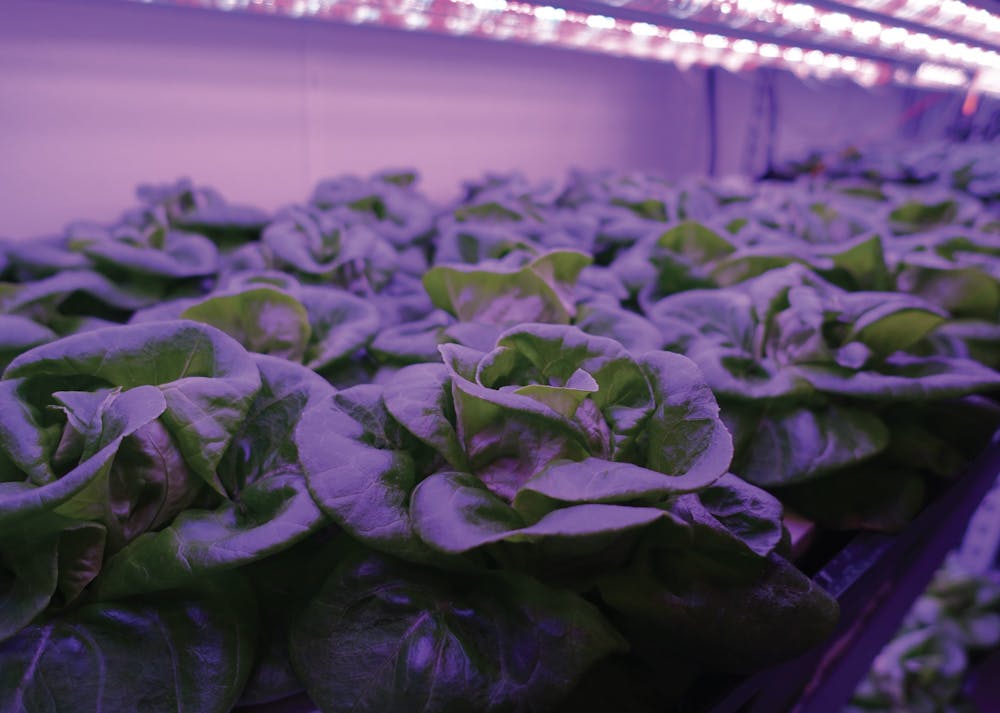The word “farm” might conjure up images of vast swaths of land covered by endless rows of crops. A vertical farm might conjure up images of scientists inside laboratories wearing starch-white lab coats, examining soil samples with microscopes. It’s time to remove those images from your mind and plant the seed of imagination: a vertical farm in your kitchen.
Grappling with a longstanding drought, Arizona farmers currently use over 70% of Arizona’s water supply for irrigated agriculture. Drought and water cutbacks have forced some to reduce their planting in recent years. Facing an agricultural crisis, Zhihao Chen, an instructor at the College of Integrative Sciences and Arts and an owner of Homer Farms, a startup that works to convert organic waste into bioenergy and liquid fertilizer for vertical farms, decided to look for a solution.
He found it indoors — through vertical farming, to be exact. By employing a combination of artificial lighting, water mixed with nutrients and stacks of trays holding leafy greens, vertical farming uses up to 90% less water than traditional farming and yields 10 times more crop in the same amount of space used to grow on traditional farms, according to ASU News.
In fall 2022, ASU’s College of Integrative Sciences and Arts began offering a certificate program in indoor farming led by Chen and his colleague Yujin Park, an assistant professor at CISA.
Students in ASU’s Indoor Farming Lab learn about vertical farming and have opportunities to be recruited and trained with applicable knowledge the industry is looking for, Chen said. Some students who have completed the program have later been hired by Homer Farms.
Matthew Easter, a junior studying sustainability, joined the Indoor Farming Lab because he wanted to get career experience and was interested in the science behind vertical farming.
“I come from a family of farmers ... it seems that the genes somehow got passed onto me,” Easter said. “I think that indoor farming is a way that we can provide food in a way that is sustainable.”
Vertical farming can allow for fresh produce that isn’t normally able to grow in Arizona to be produced locally, Easter said. “This controlled environment in which we can grow things allows us to have much more fresh options in locations that desperately need them.”
The Indoor Farming Lab mainly grows leafy greens, strawberries and herbs due to the high cost of vertically growing other plants, such as grains. Because the conditions in which the plants grow are meticulously controlled, Park and student researchers can ensure their nutritional value by adding nutrient solution.
For plants with medicinal properties, like marigolds, the Indoor Farming Lab “can manipulate all the environmental factors so that we can increase certain vital chemicals to increase the nutritional value,” Park said.
Farming for the home
Chen and Park are working with the city of Phoenix to help the general public build small-scale vertical farms inside their homes. The two are planning to host workshops to educate residents about vertical farming techniques, targeting those who live in food deserts.
If residents want to sell their crops, Homer Farms will buy the produce and distribute it to its buyers. That way, if small businesses are worried about finding a market for their produce, Homer Farms can help them get their foot in the market, Chen said. They can also keep the produce for themselves to have fresh food grown right in their home.
Jonathan Ries, a graduate student studying applied biological sciences, envisions vertical farms in people’s homes becoming commonplace in the future. In fact, he already has one in his own home.
His prototype, constructed from PVC pipes, is a bit specialized, but someone could even use buckets bought from Home Depot and start their vertical farm, he said.
“For the average person who just wants some fresh produce and maybe doesn’t like getting their hands dirty, doesn’t want to dig into the ground, (vertical farming) seems like such a good solution for people who want that produce literally in their kitchen,” Ries said.
Personal vertical farms are fairly low maintenance once they get started — Ries only needed water, LED lights and nutrients, which he bought on Amazon. In Arizona, vertical farms can even be placed outdoors, eliminating the need for LED lighting.
In the future, “I think we’re going to be at a point where we have to farm indoors,” Ries said.
Ries sees vertical farming becoming a necessity in the future, on both a large and small scale, due to its water efficiency, faster food production and regional accessibility. In rural communities, he said neighborhoods could have farms nearby or inside them, instead of having to drive miles to the nearest grocery store, due to the small amount of space required for a vertical farm — the ASU Indoor Farming Lab started in two standard shipping containers.
Homer Farms is also in the process of renovating a 10,000 square foot warehouse to vertical farm in Phoenix with the goal of creating a more resilient food system for the city. The farm is predicted to grow a minimum of 500,000 pounds of produce a year. Both the training and the farm are supported by the Phoenix Resilient Food System Initiative, originally adopted in 2021. The vertical farm is expected to start cultivating food in March, Chen said.
The initiative is designed to decrease food insecurity and create a more resilient food system in Phoenix so the city will be less impacted by disruptions to the supply chain, which during the pandemic exacerbated the need to have a strong local food network.
The sustainability benefits of vertical farms don’t end at the saved space and water. The vertical farms at ASU, in partnership with Homer Farms, convert food waste, including waste from football games, into liquid fertilizer for the produce, Chen said.
Farming for the future
In addition to providing more food than traditional farming methods, vertical farming can be a more environmentally conscious way to grow mass amounts of crops to sustain a resilient — and ever-expanding — food system.
Vertical farming can be certified organic, said Kathleen Merrigan, executive director of the Swette Center for Sustainable Food Systems and former U.S. deputy secretary of agriculture.
Organic foods avoid synthetic pesticides, reducing farmers’ exposure to air and water pollution, a report Merrigan co-authored found. Organic farming also protects the health of farmworkers, farmers and the environment, according to the report.
“Most of them (farmers) have come to some sort of epiphany in their life,” Merrigan said. “That the way they were producing with intensive use of chemicals makes no sense for the health of their family (and) their farmworkers.”
Vertical farming is great for reducing water use in agriculture. But energy use? Not so much. “The big issue around vertical farms is the electrical use,” Merrigan said.
Energy makes up 50-70% of the cost of goods sold for vertical farms. Renewable energy, like solar panels, can offset the costs, but they also require more square footage than vertical farms typically have. As technology continues to evolve and LED lights become more efficient, vertical farming becomes more desirable, Merrigan said.
According to Chen, while vertical farming is great for leafy greens and herbs, it’s a different story when it comes to cultivating crops like rice and wheat. The energy required to grow grains in a vertical farm doesn’t match up to the market value of the crop, Chen said, leaving those in the field looking for ways to innovate.
Still, Park and Chen hope that the vertical farming program at ASU will help reshape the future of agriculture in Arizona and the Southwest — especially amid ongoing drought.
This initiative comes at a time when some farmers in Arizona are looking for ways to use less water for their crops, according to Chris Udall, executive director of the Agribusiness & Water Council of Arizona.
At the start of 2023, farmers in Pinal County lost all of the remainder of their access to the Colorado River entirely. Arizona has taken the lion’s share of cuts to reduce its water use compared to California, which gets almost half of the lower basin’s water apportionment.
“Farmers are very good about being able to adjust to water conditions,” Udall said. There are farmers who would shift to producing crops with less water, but there needs to be a demand for them, he said.
“Farmers do what they do for a reason,” Udall said. “A lot of them, if not all of them, look to experiment on everything possible to help them raise a crop.”
Farmers are looking to make a profit, and water is a huge factor in meeting an agricultural bottom line. Some farmers are looking into vertical farming, but energy and startup costs can often be barriers. Vertical farms must make nearly six times more money than conventional farms to break even, according to a report from CoBank, an agribusiness bank.
“I think that there’ll be a lot that look at vertical farming as an option if it’s affordable and they can make a profit,” Udall said. “(They’re) businessmen and they are cognizant of costs and inputs. This is a real opportunity.”
Andy Etchart, an employee and the great-grandchild of the founder of Everkrisp Vegetables Inc., a third-generation family-owned farm in Arizona, said in an email that sustainable farming has always been a part of the company’s identity.
“We are constantly thinking about not compromising the ability of future generations to meet their needs both on a personal and broad scale. We are currently in the third generation of Everkrisp and want that to continue for many more,” Etchart said in an email.
Etchart is concerned with the future of hydrology in the Southwest, including access to water from the Colorado River. That concern has led to the farm implementing more efficient irrigation, such as drip irrigation.
The farm doesn’t see vertical farming in its future, and Etchart said that startup costs are high.
“It appears to us that many producers in this space are working with venture capital and/or private equity groups whose main purpose in these ventures is return on investment. (Return on investment) isn’t at the heart of why we farm and doesn’t seem in the best interest to the people of Arizona,” Etchart said in an email.
While concerned about the future of farming in Arizona, Etchart still has hope: “Farmers (are) crafty and resilient and people need to eat.
“More broadly, we want the people of Arizona to have fresh, local produce for decades to come,” Etchart said in an email. “As that vision seems less and less likely we focus more and more on trying to make it come true.”
Edited by Sam Ellefson, Camila Pedrosa, Alexis Moulton and Greta Forslund.
This story is part of The Automation Issue, which was released on March 15, 2022. See the entire publication here.
Reach the reporter at kbippus@asu.edu and follow @BippusKeetra on Twitter.
Like State Press Magazine on Facebook and follow @statepressmag on Twitter and Instagram.





